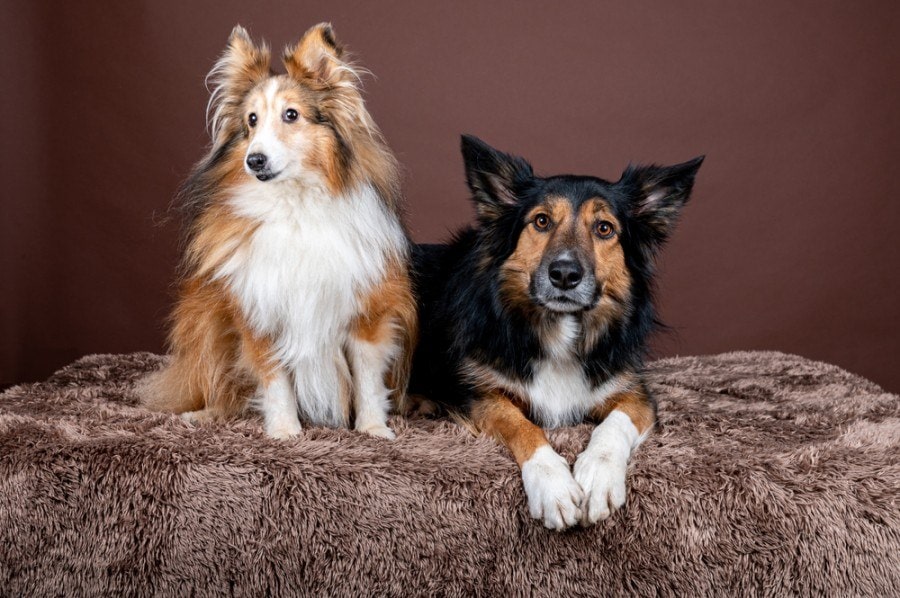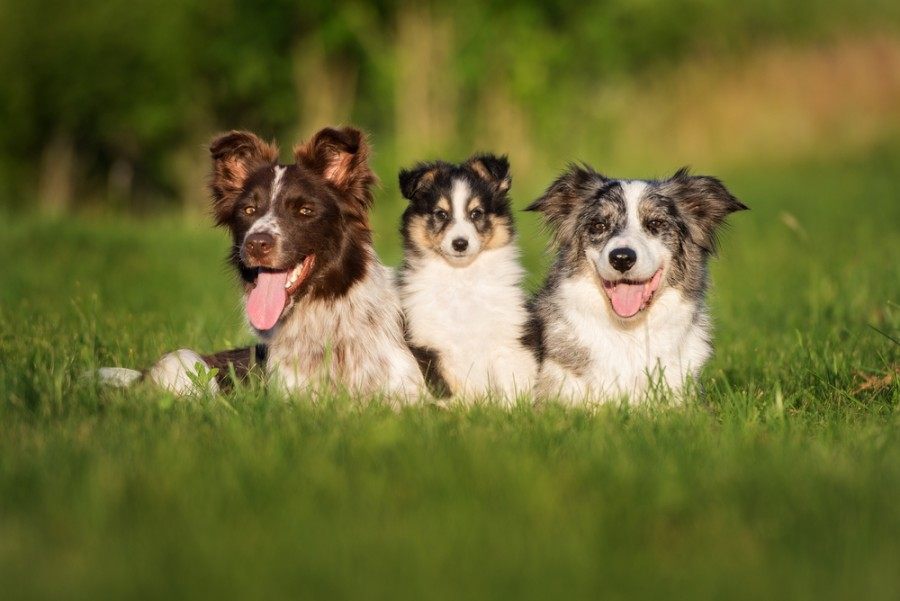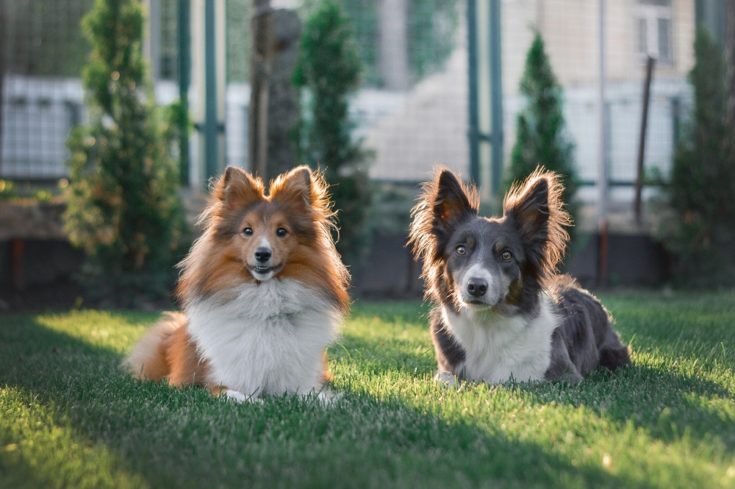Border Collie Shetland Sheepdog Mix: Info, Pictures, Facts & Traits

Updated on

| Height: | 16–22 inches |
| Weight: | 25–42 pounds |
| Lifespan: | 10–17 years |
| Colors: | White, brown, tan, cream, red |
| Suitable for: | Very active people with lots of time to spare. Experienced owners with older kids. |
| Temperament: | Active and intelligent. Loyal, playful, and loving. Independent with a strong will. |
The Border Sheepdog is a great companion dog for the right pet parent. You need to have experience with active canines, love the outdoors, and be ready to have a spunky pup as a companion.
This designer breed has a lot to offer their prospective new owners. Dog adoption is like buying a car, and you’ll want to know all the details before you bring it home! Of course, it’s even more critical because this four-legged friend will be part of your family!
Border Sheepdog Puppy
The Border Sheepdog is a relatively new designer breed from a purebred Border Collie and a purebred Shetland Sheepdog. With such a new hybrid, there is limited information about them, yet we can glean a lot from looking at the pup’s parents.
Both parents are part of the working class. The Border Sheepdog comes from intelligent and agile herding canines that have passed all their best qualities to their hybrid offspring. As a puppy, you should be prepared for them to have a lot of energy. This energy needs to be channeled properly; otherwise, you will lose a few precious household items.
We will talk more about exercise needs and training later, but for now, you should know that puppies can get in trouble from following their nose and giving in to their herding instincts.
How to Find A Good Breeder?
There are two aspects to finding a good breeder. The first is the research. You can start with kennels recommended by canine clubs the breed is associated with. Since they are hybrids, those might be far and few between for now.
Reviews from other pet owners can give you a lot of information on the kennel. With a little digging, there is a lot of info you can uncover. The second key aspect is to speak up! When you are at the kennel, don’t be afraid to tour the location, meet your pup’s parents, and meet the other animals.
Documents confirming their vaccinations, copies of veterinary visits, and purebred verification of the parents should also be included.
3 Little-Known Facts About the Border Sheepdog
1. The Border Collie
As one-half of the Border Sheepdog, the Border Collie is considered one of the most intelligent herding dogs in the world. They have been known to adapt to new situations while herding without guidance or training.
2. Two Breed Lines
The Border Collie also has two breed lines: show and work. You can ask your breeder which line your Border Sheepdog comes from.
3. Shetland Sheepdog
The Shetland is commonly referred to as the “fairy dog” due to their fluffy coat and angelic face. They are also intelligent herding dogs.

Temperament & Intelligence of the Border Sheepdog 🧠
The Border Sheepdog is an energetic, loyal, and devoted pet that requires a firm hand and a very active pet parent. If you are a novice dog owner, they might not be the best breed for you. They are constantly on the go and require a lot of mental stimulation to keep them happy and healthy.
The Border Dog is probably too smart for their own good. We recommend you have a fenced-in yard for them to play in and other activities to keep them occupied. If you are looking for a cuddle buddy to watch movies, they are not likely to cooperate.
However, you find this breed to be very loving and loyal. They thrive on human connection and create a strong bond with the person who spends the most time with them. The Sheepdog is eager to please you, and they enjoy a nice long scratch.
On the flip side, they have an independent, stubborn, and fearless side. This is a dog who wants to get their way. They will attempt to stare you down to get what they want. Once your position as the boss has been established, however, they are incredibly obedient pets.
You will also notice that this pup is protective of their family. You can rely on them to be good guard dogs, though they can bark incessantly if not appropriately trained. For the most part, they will not be inclined to trust strangers right away. It will take to gain the Border Sheep dog’s trust.
Are Border Sheepdogs Good for Families? 🏡
If your family is athletic, and your kids are on the older side, the Border Sheepdog will make a great family companion. Nothing will make them happier than following the kids outside to play soccer, going on family hikes, or following you around as you mow the lawn.
That is also why apartments are not the ideal residences. Homes with a lot of space are good, but a big fenced-in yard is best. The Border Sheepdog will also make a great companion for a single person, provided they have a lot of time to spend with them.
Although they are not likely to have separation anxiety, the boredom of being alone too often can cause just as many issues. We also don’t recommend this canine for homes with seniors or small children. The Border Sheepdog can be unruly and stubborn, so they need to be in the care of someone who can handle them.
Do Border Sheepdogs Get Along with Other Pets? 🐶 😽
When keeping other pets with your Border Sheepdog, you want to proceed with caution. Again, due to their stubborn and rambunctious nature, smaller dogs or puppies are typically not the best roommates. The same goes for smaller animals like cats.
The herding instinct is strong in this dog, and they will do their best to keep other pets in a specific location. On the other hand, older dogs of equal or bigger size tend to do better along with felines that are not easily intimidated by Border Sheepdogs.
Keep in mind early socialization in this dog is essential. If you start training early and are consistent with it, your Border Sheepdog will likely be well-rounded and happy to engage with other pets. However, those who are not introduced to other animals and sounds as a puppy will have a harder time adjusting.

Things to Know When Owning a Border Sheepdog:
Food & Diet Requirements 🦴
Border Sheepdogs will need healthy sources of protein and fat to keep their muscles lean and strong, give them energy, and keep them flexible. Fiber is also needed to keep their digestive system working well, and it promotes positive gut health.
These three elements should be in each food item you give your dog, whether it’s their food, meals, or treats. They are not the only ingredients for a healthy meal plan, however. Most dogs also need varying levels of antioxidants, probiotics, omega fatty acids, vitamins, and minerals. All of these nutrients combined will ensure they are getting what they need to be healthy and strong.
Diet Plans
Although all those staples are required in your dog’s diet, the amounts of each can vary. It will depend on your Border Sheep dog’s age, health, size, and activity level. For example, this hybrid is on the high side of the energy chart, so their diet should reflect that.
Exercise 🐕
By now, we are sure you have surmised that this dog will need a considerable amount of exercise. We recommend taking them out for a least an hour two times a day. You can decide which activity is best, whether you jog, hike, bike, etc., but brisk walking should be the minimum.
Daily outings are not the end of it, either. The Border Sheepdog should also be given additional playtime in the backyard, preferably with you. They will benefit greatly from games of fetch, frisbee, tug of war, and chase. Agility courses, specific jobs they can be taught, or other physical activities that engage their mind are also essential.

Inactivity Issues
A Border Sheepdog that is not exercised regularly will pick up bad habits. They will chew on your furniture, bark consistently, dig, and snap at people and other pets.
This is nothing compared to the mental anguish they endure, however. Inactivity will cause your pet to become bored, anxious, and depressed. Like us, this can affect their appetite, health, and mood over time. That is why you must commit yourself to daily exercise with your Border Sheepdog.
Training 🦮
Training your Border Sheepdog should be started when they are a small puppy. The earlier you start, the better their temperament will be as they mature. Training in obedience, behavior, housebreaking, and socialization are vital but not the only areas.
Before we get into extra training, we want to touch on the basics first. The Border Sheepdog has a mind of their own. They can be willful and stubborn at times, and they have an independent nature due to their high intelligence.
Being the Alpha Dog
Luckily, their intelligence makes them a quick study for training as long as you can appoint yourself as the leader. This will require you to become the Alpha by not giving in to their stare or their cute antics.
Being the leader requires you to intimidate your pet. Yelling, hitting, or abusing the animal is not only going to have the opposite effect, but it is also a crime in most places. Instead, dogs respond well to positive reinforcement.
It is essential that you reinforce all of your commands and rules but in a positive way. Praise and treats work wonders with this hybrid, but you must be consistent and firm. You should also be prepared to repeat the lessons over and over.
Other Training
If you start training early and you successfully get over the first hurdle of training, teaching them other things will be a lot easier. As we mentioned above, teaching them tricks, games, responsibilities, and other fun activities will not only be in their best interest, but they will also love doing them!
Besides that, you will also want to get them used to being groomed.
Grooming ✂️
The coat on your Border Sheepdog can vary depending on which parent they take after. They will typically have medium-length straight fur. Each of them will also have an undercoat that you must contend with. The Border Sheepdog is also a moderate shedder that sheds heavily twice a year.
During the “normal” times of the year, you must brush your dog two to three times per week, but here’s where it gets tricky. You need to use a combination of three brushes. First, you will need an undercoat rake to release and shed and remove any tangles from their soft inner fur.
You will then need a pin brush for the outer layer along with a slicker brush. You want to use the undercoat rake each time you groom them. The pin brush will help remove the loose hair and keep mats from forming. The sticker will also remove excess fur while smoothing and shining their coat. During heavy sheds, you want to increase brushing to seven days a week.
Bathing, Cleaning, Clipping, and Brushing
Thankfully, taking care of their coat is the most time-consuming grooming task, but you will still need to take care of baths, teeth cleaning, nail clipping, and ear cleaning. Bathing your Border Sheepdog too often can cause their fur to lose some of its natural oils, which keep their coat shiny and strong.
Twice a week, you will also want to inspect their ears for mites, redness, and excess ear wax. Even if you don’t see anything, you must wipe their ears clean with a cotton ball and a canine ear-cleaning solution. Your vet can recommend one that works well.
You will also want to brush their teeth regularly. Now, teeth cleaning is typically not appreciated by your pup, so try to get in there at least once a week. You can supplement brushing with dental treats.
Finally, you will need to trim their nails. This should be done on an as-needed basis, but the Border Sheepdog is incredibly active, and they can usually go longer than the average dog. A good rule of thumb, however, is if their nails are tapping the floor, it’s time to trim. A guillotine clipper is best, but a grinder can also smooth the edges if they are jagged.
Health Conditions ❤️
Did you know that eliminating health issues is one of the more popular reasons for crossbreeding purebreds? Some experts believe that due to the amount of purebred canine inbreeding, crossbreeding can keep disease and hereditary concerns low.
However, there is yet to be any conclusive proof that this theory is true. Any issues a dog’s ancestors had can be passed down through genetics. For the most part, the Border Sheepdog is a healthy pet, but there are some health concerns you should be aware of before adopting. We have broken these issues into serious and minor conditions.
- Cataracts
- Hip dysplasia
- Paninis
- Eye-lid defects
- Corneal dystrophy
- Von Willebrand’s disease
- Patent Ductus Arteriosos
- Collie Eye
Final Thoughts:
If you are an avid outdoorsman, live on a farm, love spending time with your dog, and are constantly on the go, the Border Sheepdog could be the right pet for you. Not only are they willing to keep up with you during all types of activities, but they will provide you with companionship that is loving, protective, and fun!
The Border Sheepdog is a medium-sized pet with a lot of personality and spirit. They thrive with human connections, plus they are spunky, independent, and alert. We hope this article has given you all the details you need about this designer hybrid!
See also:
- American Eagle Dog (American Eskimo Dog & Beagle Mix)
- Eskimo Schnauzer (American Eskimo & Miniature Schnauzer Mix)
Featured Image Credit: Shutterstock













